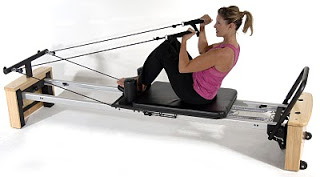Pilates is a form of exercise, originally designed for dancers and athletes, that focuses on building spinal stability and core strength as well as stretching and building lean muscle. Its no wonder this exercise has become so trendy among celebrities and movie stars who need to maintain a strong and healthy body to adhere to the demands of public visibility and high-pressure projects. After practicing Iyengar yoga for many years, I started doing Pilates because I wanted to build better strength and balance, while keeping the focus on precise alignment and posture. The mixture of challenging/strengthening and stretching/relaxing movements provides considerable stress relief, and the engagement and focus required improves concentration and mental alertness. I recommend a complementary Pilates or yoga practice to my psychotherapy clients as a way of managing the deep emotions and personal vulnerability which therapy brings up. Below, I summarize some major potential mind-body benefits of Pilates practice:
(1) Mindfulness & Focus
Pilates exercises require a mindful focus on the body so as to maintain stability of the core muscles in spine and abdomen while moving arms, legs, or torso. The movements are smooth, stretching, and flowing, leading to a relaxed body awareness and focused attention. The philosophy of Pilates is to understand and accept your current capacities and slowly work towards improvement, rather than trying to force things. This approach builds self-awareness and self-acceptance that can be applied to other aspects of life. Also, the focus on moving mindfully rather than automatically can be applied to other life areas.
(2) Spinal Stabilization
Pilates is particularly helpful to individuals with back pain or arthritis because it stabilizes and strengthens the muscles around the spine. Research shows that the transverse abdominus and multifidi muscles are involved in spinal stabilization. Following an injury, the spine can get out of alignment, either due to the injury itself or the person’s attempts to compensate by making postural changes. The deepest layer of transverse muscles in the abdomen wrap around the spine and help to stabilize it. Therefore strengthening these muscles can both prevent and diminish low back pain as well as improving posture and strength.
(3) Core Strength
The core muscles are those in the back and abdomen. Pilates exercises strengthen these muscles, leading to better posture, better balance, flatter abs, and more resistance to injury. This physical strength can also translate into more mental resilience and ability to withstand stress and demanding routines. Pilates can also enhance body image, suggesting that people with subclinical or clinical eating disorders might benefit. Building lean muscle can also enhace weight loss.
(4) Breathing and Relaxation
Pilates exercises require a focus on the breath as participants move with in and out breaths. Breathing may be lengthened to accommodate the movement, and awareness of breathing is enhanced. The combination of deep breathing and rhythmic stretching movements can lead to deep relaxation and stress relief. More intensive Pilates also has an energizing quality, because of improvements in the flow of oxygen through the body. Doing Pilates two to three times a week provides a moderately challenging fitness routine that can enhance performance in other sports as well.
Optimal health requires work on both the mind and the body. In my opinion, the most beneficial body work is in harmony with mental and emotional functioning. Exercises such as Pilates strengthen and condition both mind and body and give my clients strength to enact behavioral changes that are an important part of successful therapy.



Fantastic. I love that you encourage clients to find a way to physically work through issues that are coming up for them! The relationship between body & mind is so entwined!
Melanie,
I encourage my clients to engage in activities that incorporate mindfulness practices. I find it helps them to become aware of their experience in the present moment. Hence, they are able to see they have choices in how to relate to their pain and or suffering. Empowering for many.
In the process of "touching" pain and suffering, exposure occurs. Consequently, it is similar to how phobias are treated by exposing clients to the the very thing they want to run away from.
I will include pilates as one of those activities as a recomendation for clients.
Thank you,
Brenda Bomgardner
http://www.creatingyourbeyond.com
brenda@creatingyourbeyond.com
Brenda,
Thank you for your comment and nice explanation of mindfulness in terms of choice. You can't take the experience of suffering away, but you can view it in a way that is more peaceful and empowering. Pilates involves mindfulness and also builds physical strength and flexibility. It's a kind of exposure in that the weight-bearing exercises are difficult until you build up the strength and ability to isolate core muscles. Once you learn that, it transforms your experience of exercising!
I love pilates and yoga! great way to get in core shape and be in the moment!
Thanks Kathy.They blend really nicely with psychotherapy in teaching people breath and body awareness.